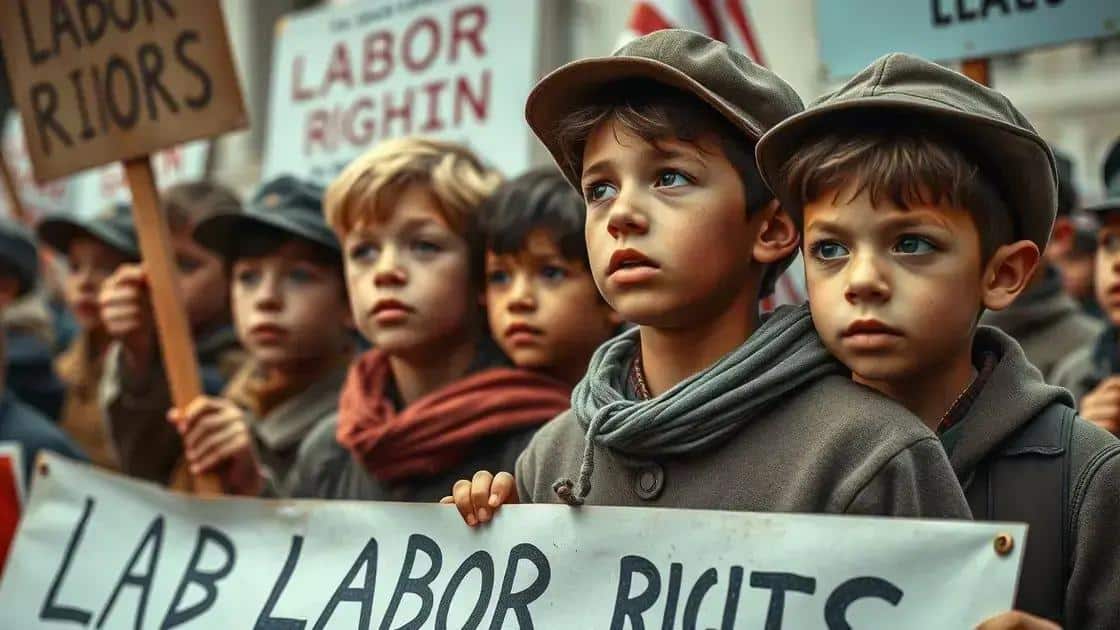Boy labor movement stories: uncovering hidden truths

The boy labor movement stories highlight the struggles of young activists advocating for fair wages, better working conditions, and access to education, emphasizing the importance of unity and resilience in the fight for children’s rights.
Boy labor movement stories offer a glimpse into the lives of young individuals who fought bravely for their rights. These narratives not only highlight their struggles but also inspire us to reflect on the ongoing challenges faced by children in the workforce today.
Historical overview of boy labor movements
The historical overview of boy labor movements provides essential insights into the struggles faced by young workers. Throughout history, boys have played a critical role in labor movements, advocating for their rights and better working conditions. Understanding their contributions helps us appreciate the progress made in child labor laws.
Early boy laborers and their roles
In the late 19th and early 20th centuries, many boys worked in factories, mines, and farms. They faced harsh conditions and long hours, often sacrificing their education for survival. Some key factors contributing to the rise of boy labor were:
- Poverty in families needing additional income.
- High demand for inexpensive labor during the Industrial Revolution.
- Limited access to education for lower-income families.
These realities prompted young boys to join forces and advocate for change. Driven by desperation and hope, they organized strikes and protests, making their voices heard.
Major labor movements involving boys
Several significant labor movements featured the active participation of boys. The early 1900s saw many unions forming, which included young members. These movements aimed for:
- Reduced working hours.
- Improved safety regulations.
- Access to education for child workers.
Throughout these times, stories of these young activists inspire us. For instance, the National Child Labor Committee advocated strongly against child labor, leading to significant changes in laws. Such efforts helped lay the groundwork for future labor rights.
As the movements grew, so did public awareness. Newspapers began to cover the struggles of these child laborers, bringing attention to their plight. This shift in public perception contributed to changes in legislation that aimed to protect children from exploitation.
Today, the legacy of these boy labor movements remains vital. They remind us of the ongoing fight for children’s rights and the importance of protecting vulnerable populations.
Personal stories from young labor activists
Personal stories from young labor activists provide powerful insights into the realities of child labor. These narratives showcase the courage and determination of boys who stood up for their rights. Each story reflects the challenges and triumphs they faced in their fight for better working conditions.
Voices of change
One inspiring story is that of a young boy named Tom who worked long hours in a textile factory. He was determined to make a difference for himself and others. Tom organized fellow workers to demand fair wages and shorter work hours. His bravery was contagious, encouraging others to join the cause.
Another notable activist, Jaden, was just twelve years old when he led a strike at his local sweatshop. Jaden believed that every child deserved an education. By rallying his peers, he highlighted the importance of attending school instead of working long shifts. His efforts caught the attention of local newspapers, amplifying their message.
Impact of personal stories
These personal stories resonate far beyond their immediate context. They illustrate the resilience of children who refuse to accept unfair treatment. As more young activists emerged, their stories began to shift public perceptions about child labor. The courage displayed by these boys became symbols of hope and change.
- Tom’s advocacy led to improved safety regulations in factories.
- Jaden’s strike raised awareness about child labor laws.
- These activists paved the way for future generations to fight for their rights.
Through their experiences, we understand the significance of grassroots activism. The stories of young labor activists continue to inspire new movements. They remind us that change is possible when young voices are heard.
Impact of legislation on boy labor

The impact of legislation on boy labor has been significant in shaping the lives of young workers. Laws created to protect children from exploitation have changed the landscape of labor. These changes seek to prevent child labor and ensure that boys have the right to education.
Key legislations in history
In the early 1900s, several important laws were enacted to combat child labor. The Fair Labor Standards Act (FLSA) is one of the most notable. It aimed to establish minimum wage and maximum hour standards for workers, including minors.
- The Keating-Owen Act of 1916 was an early attempt to restrict child labor.
- The Child Labor Act of 1938 aimed at setting age limits and regulating working conditions for young laborers.
- Each law laid the groundwork for future child protection initiatives.
As these laws evolved, they forced various industries to rethink their hiring practices. Many factories and farms could no longer exploit young boys. This shift allowed children more access to education, which is crucial for their development.
Further developments and effects
Today, legislation continues to evolve, addressing newer challenges faced by young workers. Companies are held accountable for ensuring a safe environment. Child labor laws now include provisions that focus on:
- Prohibiting minors from dangerous jobs.
- Mandatory educational requirements.
- Enforcement of age verification in hiring practices.
These advancements have resulted in more children attending school and fewer working long hours in hazardous conditions. Monitoring agencies work to enforce these laws, safeguarding the rights of young laborers.
Overall, the impact of these legislations illustrates society’s commitment to protecting children. Changes in laws reflect a growing understanding of the importance of education and safety for boys in the workforce.
Comparative analysis of boy labor globally
The comparative analysis of boy labor globally reveals stark differences in child labor practices across various regions. Each country has its own unique challenges and legal frameworks that affect how boys engage in work. Understanding these differences helps to highlight areas needing attention and reform.
Regions with high boy labor prevalence
In some countries, boys are still integral to the workforce. For instance, in parts of South Asia and Sub-Saharan Africa, boys often work in agriculture or manufacturing. Children from poorer backgrounds may not have access to education, leading them to labor instead.
- In Bangladesh, many boys work in the garment industry, often under hazardous conditions.
- In India, child labor persists in agriculture, where boys are needed for manual tasks.
- In Nigeria, boys engage in mining, risking their health and safety.
These scenarios underline the urgent need for reforms and protections in countries where boy labor is prevalent. Furthermore, global organizations aim to address these issues through various initiatives.
Positive trends in legislation
On the other hand, some countries have seen improvements in child labor laws. Nations like Germany and Canada enforce strict regulations that prevent children from engaging in hazardous work. Initiatives that promote education have increased enrollment rates for boys, allowing them to prioritize schooling over labor.
- Canada has programs to support education for at-risk youth.
- Germany invests in vocational training to keep boys in school.
- Educational campaigns help raise awareness about child rights.
This progress highlights the successes that can emerge when nations prioritize the welfare of children. It also shows the impact of community engagement in driving change.
By examining these trends, it’s clear that the fight against child labor requires a coordinated global effort. Different regions can learn from each other’s successes and challenges to work towards a common goal: protecting children’s rights and ensuring access to education for all boys.
Lessons from boy labor movement histories
The lessons from boy labor movement histories offer valuable insights into the fight for children’s rights. These movements teach us the importance of advocacy and community. By studying past experiences, we can understand what strategies worked and how to apply them today.
Importance of unity
One key lesson is the strength found in unity. Young activists often joined forces to advocate for their rights. For instance, during the early 1900s, boys in different industries organized protests together. This collective action showed that they could demand change more effectively as a group.
- Strong networks helped spread awareness of their issues.
- Unification led to larger demonstrations, drawing public attention.
- Building solidarity encouraged more boys to participate.
These strategies can serve as a model for current movements. When young people come together, their voice is amplified, increasing the possibility of achieving their goals.
Advocacy and awareness
Another important lesson is the role of advocacy in creating change. Many successful labor movements used creative approaches to raise awareness. For example, boy laborers shared their stories through newspapers and pamphlets. This outreach was crucial in educating the public about their struggles.
- Storytelling made their experiences relatable to others.
- Public campaigns raised awareness and support.
- Engaging communities encouraged them to join the cause.
These efforts highlight the value of communication in activism. Engaging with the public helps build understanding and support for any movement. This remains true today as young activists use social media to spread their messages.
In addition to unity and advocacy, learning from past mistakes can be insightful. Boy labor movements faced backlash and challenges. Recognizing these hurdles helps contemporary advocates prepare for similar struggles. By reflecting on history, young activists can adapt their strategies to meet current needs.
Ultimately, the history of boy labor movements teaches the importance of resilience. Advocates can draw inspiration from their predecessors, reminding us that change is possible when effort and commitment are high.
In conclusion, the history of boy labor movements teaches us vital lessons about unity, advocacy, and resilience. By coming together, young activists can amplify their voices and inspire change. The stories from the past remind us of the importance of fighting for children’s rights and the impact one can make when advocating for a better future. As we reflect on these lessons, we are encouraged to continue striving for a world where every child has the freedom to learn and grow.
FAQ – Questions about boy labor movements and advocacy
What were the main goals of boy labor movements?
The main goals included advocating for fair wages, better working conditions, and access to education for young workers.
How did young activists raise awareness about their struggles?
Young activists shared their stories through newspapers and pamphlets, and organized protests to draw public attention.
What lessons can we learn from the histories of boy labor movements?
We learn the importance of unity, advocacy, resilience, and how to adapt strategies based on past experiences.
How can we support the rights of young workers today?
We can support them by advocating for stronger child labor laws, raising awareness, and promoting education.






